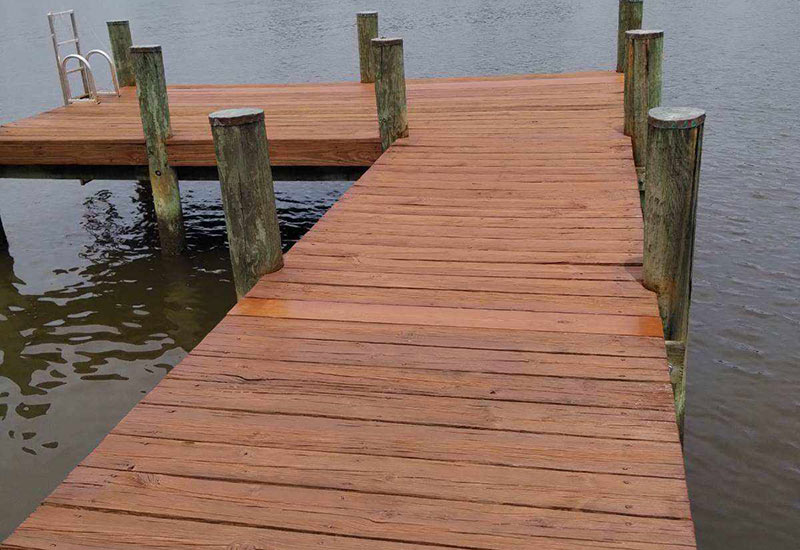Everything You Need To Know About Dock Maintenance in Maryland
Everything You Need to Know About Dock Repairs in Maryland
Proper dock maintenance prolongs the life of your waterfront investment and keeps your on-the-water experiences safe and enjoyable. Whether you’re a homeowner with a cozy boat dock on the Chesapeake Bay or you run a bustling marina, understanding how to care for your docks is essential. As you read below, we’ll answer everything Maryland dock owners need to know, from spotting common issues to performing floating and standing dock repairs. Along the way, you’ll pick up expert tips for wooden dock repair, when to seal your dock, and how to recognize when it’s time for a full replacement.

Why Regular Boat Dock Maintenance Matters
Your dock is more than a landing spot for your boat. It’s a key piece of your property, exposed to constant stress from waves, sun, and storms. Regular boat dock maintenance doesn’t just ensure longevity. It guards against costly repairs, safety hazards, and environmental damage. Unattended problems can escalate quickly in Maryland’s coastal climate. Saltwater, humidity, and variable temps accelerate wear and tear, while storms and ice can cause unexpected damage. Routine inspections and maintenance help you catch minor issues before they require expensive professional dock repair.
Common Problems That Require Floating Dock Repair
Floating docks are popular across Maryland’s rivers and bays for their flexibility and ease of installation. However, they also face unique maintenance challenges. Recognizing early warning signs of floating dock issues can save you serious time and money. Common floating dock repair needs include the following:
- Punctured or leaking floats: Waterlogged or cracked floats compromise buoyancy.
- Loose or corroded hardware: Rusty bolts, loose nuts, and worn brackets can unbalance your dock.
- Decking wear: Boards can warp, splinter, or separate with exposure to sun and tides.
- Algae and barnacle buildup: Left unchecked, marine growth can make surfaces slippery and degrade materials.
- Misaligned anchor lines: Shifting in storms or strong currents can damage connections to land or moorings.
Floating Dock Maintenance Tips
Proper maintenance is key to extending the life of your floating dock and ensuring its safe functionality. Addressing everyday wear and tear can prevent minor issues from becoming costly repairs. Below are some essential tips to help you keep your dock in top condition:
- Inspect floats every season for cracks or leaks.
- Rinse hardware and structural pipes with fresh water to prevent salt corrosion.
- Remove barnacles and algae promptly, as buildup will only grow.
- Tighten bolts and check for signs of galvanized metal fatigue.
- Make sure anchor lines are secure and not fraying.
Frequent Issues That Need Standing Dock Repair
Standing or fixed docks anchored on pilings or supports are especially common on Maryland’s tidal creeks and inland lakes. Unlike floating docks, they’re stable but face their own set of challenges. Keep an eye out for the following signs you need standing dock repair:
- Rotting or splintered wood: Frequent contact with water leads to rapid deterioration.
- Corroding fasteners: Metal parts below the waterline can rust and disintegrate.
- Loose decking boards: Foot traffic and fluctuating tides cause wood to shift over time.
- Settling or shifting pilings: Erosion and freeze/thaw cycles can undermine supports.
- Visible gaps or sinking: Uneven sections signal shifting foundations or decaying materials.
Standing Dock Maintenance Checklist
Proper maintenance of your standing dock is essential to ensure its safety, longevity, and functionality. Regular inspections and timely repairs can prevent minor issues from escalating into costly damage. Use the following checklist to help you identify common problems and keep your dock in optimal condition:
- Tap pilings with a hammer to check for hollow sounds (indicates rot).
- Replace corroded or missing fasteners before boards loosen further.
- Watch for pooling water on decking, which can weaken wood and cause slips.
- Level uneven sections promptly to prevent further structural issues.
- Pressure wash algae and mildew regularly.
Repairs and Maintenance for Various Dock Materials
Maryland docks are built from several materials, each with distinct care requirements. Here’s how to extend the lifespan of the most common ones:
- Wood
- Reapply the best dock sealer annually for maximum protection against water and UV rays.
- Sand surfaces smooth to prevent splinters and splintered boards.
- Replace rotted planks as soon as they’re identified.
- Aluminum
- Rinse with fresh water after saltwater exposure to prevent pitting and corrosion.
- Check welds and joints; look for metal fatigue or cracking.
- Use non-abrasive cleaners to preserve the finish.
- Composite
- Spray down monthly to remove dirt and prevent mold growth.
- Address loose or cracked panels quickly to stop bigger issues.
- Avoid power washing at high pressure, which can damage the material’s surface.
How Often Should I Seal My Dock?
The Maryland climate demands that dock surfaces, especially wood, are well protected. For the best results, seal your dock decking and structural wood once a year. Early spring is often ideal before summer sun and humidity set in. When selecting a dock sealer, choose products labeled as marine-grade or designed specifically for docks and piers. These sealers provide maximum UV and moisture defense, helping your dock resist rot, mold, and sun bleaching.
How Do I Sand and Stain My Dock?
Sanding and staining not only refresh the appearance of your dock but also boost longevity by guarding against moisture while making shoes and bare feet safer. Step-by-step dock sanding and staining includes the following:
- Sweep the dock free of debris and scrub away algae or mildew.
- Use a power sander with medium-grit sandpaper on all flat wood surfaces.
- Wipe away dust and ensure the wood is dry before staining.
- Apply a marine-grade stain evenly, following the wood’s grain.
- Allow the first coat to dry completely, then apply a second if needed for extra protection.
Signs Your Dock May Need Replacement
Regular dock maintenance extends your investment’s life, but every structure eventually needs replacing. Knowing when to search for “dock repair near me” or a complete replacement saves time and protects your waterfront property. Look for these signs:
- Multiple support pilings are severely rotted or unstable
- Widespread soft or crumbling decking
- Recurring mold, algae, or barnacles that return quickly after cleaning
- Consistent deck warping, sagging, or significant gaps
- Structural movement, such as wobbling when walked on
- Rust and corrosion at every major joint or connection
- Excessive repairs that don’t seem to solve underlying problems
Expert Help for Dock Repair and Maintenance in Maryland
Staying on top of floating dock maintenance, wooden dock repair, and sealing schedules makes all the difference in how long your dock lasts. From simple seasonal fixes to total replacements, Marylanders rely on experts like Five Star Deck Service for reputable assessments and repairs. Whether you’re dealing with standing dock maintenance, looking for the best dock sealer, or not sure where to start, working with experienced local pros ensures your dock stays safe, strong, and beautiful season after season. Need professional help? Contact us today for expert dock repair in Maryland. Your peace of mind is only a call away.

